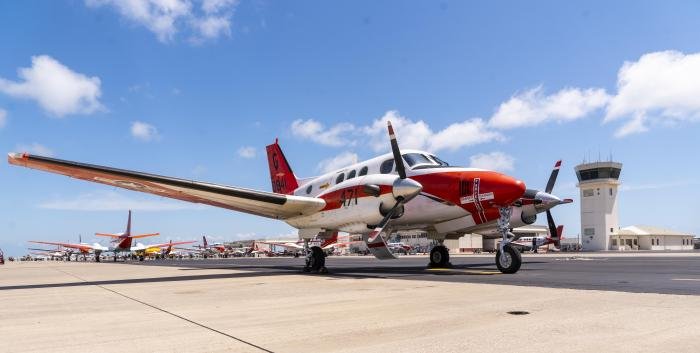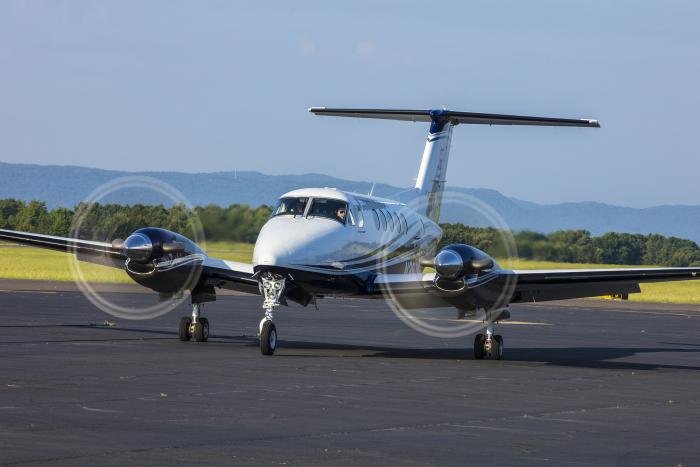US-based aircraft manufacturer, Textron Aviation, has been awarded a single, firm-fixed-price contract to develop the T-54A multi-engine training system (METS) aircraft for the US Navy, with the service seeking to procure up to 64 examples of the type to replace its ageing Beechcraft T-44C Pegasus fleet.
The recently awarded contract was announced by US Naval Air Systems Command (NAVAIR) on January 25, which added that the new T-54A – a platform that is based on the Beechcraft King Air 260 – will provide “advanced instrument and asymmetric engine handling training to student naval aviators selected for multi-engine fleet communities.” The new platform will be used to train US Navy, US Marine Corps (USMC) and US Coast Guard (USCG) pilots to fly non-centreline thrust aircraft, such as the CMV-22B/MV-22B Osprey; P-8A Poseidon and E-2D Advanced Hawkeye, among others.

An initial contract, worth $113.1m, was awarded to Textron Aviation for the development, production and delivery of the first ten airframes to the US Navy. Aircraft deliveries are scheduled to take place between 2024 and 2026. Meanwhile, the total contract award, which covers aircraft procurement, base and contract options, along with the provision of support equipment, spare parts and training services, is worth $677.2m.
When operational, the T-54A will replace the Navy’s ageing Pegasus fleet, which entered service as the T-44A in 1977, with 61 examples delivered in total. Four of these aircraft were lost to attrition and a further three airframes were withdrawn from use. From 2006 to 2016, the remaining 54 T-44As were upgraded to T-44C standard, with these aircraft currently being operated by Training Squadron 31 (VT-31) ‘Wise Owls’ and VT-35 ‘Stingrays’ at Naval Air Station (NAS) Corpus Christi in Texas. The withdrawal of the T-44C fleet is set to begin six months after the first T-54A is delivered.
Commenting on the new T-54A and how it will enhance the US Navy’s ability to train student pilots on multi-engined aircraft, Capt Holly Shoger – program manager at the Naval Undergraduate Flight Training Systems Program Office (PMA-273) – said: “The new METS aircraft will give us the ability to train pilots across the services with an advanced platform that better represents fleet aircraft. The T-54A will include the latest avionics and navigational updates, such as virtual reality and augmented reality devices, to ensure pilots are ready to face any challenges that come their way in tomorrow’s battlespace.”

The T-54A will feature a pressurised aircraft cockpit with a side-by-side seating configuration and a jump seat. In addition, the aircraft’s cockpit will be fitted with multifunctional displays (MFDs) and a digital moving map, as well as redundant UHF/VHF radios; a weather radar; flight management system; cockpit data recorder; radar altimeter; an automatic dependent surveillance-broadcast (ADS-B) system and an integrated global positioning system/inertial navigation system (GPS/INS). The platform will also feature a reconfigurable cargo bay in its cabin.
Alongside this, NAVAIR states that the aircraft will feature technology that is designed to capture data that helps to allow Conditioned-Based Maintenance Plus – “a capability that enables the Navy to trend aircraft health over time to facilitate improved maintenance planning and efficiency.” Similar in configuration to the USMC’s UC-12W fleet – a militarised variant of the larger King Air 350 – the smaller King Air 260 is powered by two 850shp (634kW) Pratt & Whitney PT6A-52 turboprop engines. It has a maximum take-off weight of 12,500lb (5,670kg) and a useful load of 3,760lb (1,706kg). The aircraft will retain full Federal Aviation Administration (FAA) type certification for single- and dual-pilot operations under day and night visual and instrument flight rules.
While NAVAIR did not expand on where the new T-54As will be based, it is very likely that they will be stationed at NAS Corpus Christi, where they would be operated by Training Air Wing 4 (TAW-4), the parent wing of VT-31 and VT-35.

